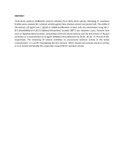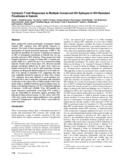Browsing Journal Articles by Title
Now showing items 5906-5925 of 29885
-
Cytotoxic activity of some Tanzanian medicinal plants.
(University of Nairobi, 2005)Thirty-three aqueous methanolic extracts obtained from thirty plant species, belonging to seventeen families were screened for cytotoxic activity against HeLa (human cervical carcinoma) cells. The ability of the extracts ... -
Cytotoxic Alkaloids From the Root of Zanthoxylum Paracanthum (Mildbr) Kokwaro
(University of Nairobi, 2022)Chemical investigation of the root of Zanthoxylum paracanthum afforded 1 new alkamide derivative, (2E,4E)-6-oxo-N-isobutyldeca-2,4-dienamide (1) together with 10 known congeners including one phenolic amide (2), four ... -
Cytotoxic and antioxidant flemingins g-p from the leaves of flemingia grahamiana
(University of Nairobi, 2014)The known flemingins A-C (1-3) and nine new chalcones, named flemingins G-O (4-12), along with deoxyhomoflemingin (13) and emodin (14) were isolated from a leaf extract of Flemingia grahamiana. The isolated chalcones were ... -
Cytotoxic benzylbenzofuran derivatives from Dorstenia kameruniana
(University of Nairobi, 2018)Chromatographic separation of the extract of the roots of Dorstenia kameruniana (family Moraceae) led to the isolation of three new benzylbenzofuran derivatives, 2-(p-hydroxybenzyl)benzofuran-6-ol (1), 2-(p-hydroxybenzyl ... -
Cytotoxic C-benzylated dihydrochalcones from Uvaria acuminata
(2004)Two new C-benzylated dihydrochalcones, isochamuvaritin (1) and acumitin (2), have been isolated from the African medicinal plant Uvaria acuminata, together with the previously reported benzylbenzoate (3), uvaretin (4), ... -
Cytotoxic Flavonoids From the Seeds of Dracaena Steudneri Engl Against Leukemia Cancer Cell Lines
(University of Nairobi, 2022)Background: Leukemia is the most common type of childhood cancer. Numerous flavonoids isolated from plants have been reported as potential chemotherapeutic agents against malignant growth while taking care of healthy c ... -
Cytotoxic flavonoids from two Lonchocarpus species.
(University of Nairobi, 2018)A new isoflavone, 4'-prenyloxyvigvexin A (1) and a new pterocarpan, (6aR,11aR)-3,8-dimethoxybitucarpin B (2) were isolated from the leaves of Lonchocarpus bussei and the stem bark of Lonchocarpus eriocalyx, respectively. ... -
Cytotoxic lupane-type triterpenoids from Acacia mellifera.
(2004)One new and eight previously described lupane-type metabolites were isolated for the first time from Acacia mellifera (Leguminosae). Based on spectral analyses, the structure of the new compound was elucidated as ... -
Cytotoxic Quinones from the Roots of Aloe dawei.
(University of Nairobi, 2014-03-17)Seven naphthoquinones and nine anthraquinones were isolated from the roots of Aloe dawei by chromatographic separation. The purified metabolites were identified by NMR and MS analyses. Out of the sixteen quinones, ... -
Cytotoxic T cell responses to multiple conserved HIV epitopes in HIV-resistant prostitutes in Nairobi.
(University of NairobiDepartment of Medical Microbiology, University of Nairobi, Nairobi, 1998-11)Many people who remain persistently seronegative despite frequent HIV exposure have HIV-specific immune responses. The study of these may provide information about mechanisms of natural protective immunity to HIV-1. We ... -
Cytotoxicity and Anti-hiv Activities of Extracts of the Twigs of Croton Dichogamus Pax
(University of Nairobi, 2022-02)Background: Acquired immunodeficiency syndrome (AIDS) is a clinical syndrome resulting from infection with human immunodeficiency virus (HIV), which causes profound immunosuppression. Anti-HIV drugs that are currently ... -
Cytotoxicity of 91 Kenyan indigenous medicinal plants towards human CCRF-CEM leukemia cells.
(University of Nairobi, 2015-12-22)ETHNOPHARMACOLOGICAL RELEVANCE: Plants from Kenyan flora are traditionally used against many ailments, including cancer and related diseases. Cancer is characterized as a condition with complex signs and symptoms. ... -
Cytotoxicity of antimalarial plant extracts from Kenyan biodiversity to the brine shrimp, Artemia salina L. (Artemiidae)
(Department of Clinical Studies, University of NairobiDepartment of Veterinary Pathology, Microbiology & Parasitology Faculty of Veterinary Medicine University of NairobiDepartment of Public Health Pharmacology and Toxicology, University of Nairobi, Kenya, 2012)Artemia salina (Artemiidae), the brine shrimp larva, is an invertebrate used in the alternative test to determine toxicity of chemicals and natural products. In this study the medium lethal concentration fifty (LC50 ... -
Cytotoxicity of antimalarial plant extracts from Kenyan biodiversity to the brine shrimp, Artemia salina L.(Artemiidae)
(Department Of Veterinary Pathology, Microbiology and Parasitology, 2012)Artemia salina (Artemiidae), the brine shrimp larva, is an invertebrate used in the alternative test to determine toxicity of chemicals and natural products. In this study the medium lethal concentration fifty (LC50 values) ... -
Cytotoxicity of antimalarial plant extracts from Kenyan biodiversity to the brine shrimp, Artemia salina L.(Artemiidae)
(2012)Artemia salina (Artemiidae), the brine shrimp larva, is an invertebrate used in the alternative test to determine toxicity of chemicals and natural products. In this study the medium lethal concentration fifty (LC50 values) ... -
Cytotoxicity Of Fagaramide Derivative And Canthin-6-one From Zanthoxylum (Rutaceae) Species Against Multidrug Resistant Leukemia Cells
(University of Nairobi, 2019)In our continuous search for cytotoxic compounds from the genus Zanthoxylum, chromatographic separation of the MeOH/CH2Cl2 (1:1) extract of Z. chalybeum yielded one new alkamide; 4-(isoprenyloxy)-3-methoxy-3,4-deoxymethy ... -
Cytotoxicity Of Isoflavones And Biflavonoids From Ormocarpum Kirkii Towards Multi-factorial Drug Resistant Cancer
(University of Nairobi, 2019)Background While incidences of cancer are continuously increasing, drug resistance of malignant cells is observed towards almost all pharmaceuticals. Several isoflavonoids and flavonoids are known for their cytotoxicity ... -
Cytotoxicity of isoflavones from Millettia dura
(University of Nairobi, 2021-08)The first phytochemical investigation of the flowers of Millettia dura resulted in the isolation of seven isoflavones, a flavonol and a chalcone. Eleven isoflavones and a flavonol isolated from various plant parts from ... -
Cytotoxicity of Plumbagin, Rapanone and 12 other naturally occurring Quinones from Kenyan Flora towards human carcinoma cells.
(University of Nairobi, 2016)BACKGROUND: Cancer is a major public health concern globally and chemotherapy remains the principal mode of the treatment of various malignant diseases. METHODS: This study was designed to investigate the cytotoxicity ... -
Cytotoxicity of selected medicinal plants extracts using the brine shrimp lethality assay from Samburu county, Kenya
(University of Nairobi, 2018)Aim of the study:This test was carried out to assess the cytotoxicity bioassay of selected medicinal plants from Samburu County, Kenya.Materials and Methods:Selectedmedicinal plants namely Clerodendrum ...






